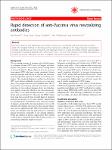Rapid detection of anti-Vaccinia virus neutralizing antibodies
Kramski, Marit
Drozd, Anna
Lichtfuss, Gregor F.
Dabrowski, Piotr Wojtek
Ellerbrok, Heinz
Increasing infections with Monkeypox and Cowpox viruses pose a continuous and growing threat to human health. The standard method for detecting poxvirus neutralizing antibodies is the plaque-reduction neutralization test that is specific but also time-consuming and laborious. Therefore, a rapid and reliable method was developed to determine neutralizing antibody titers within twelve hours. The new assay measures viral mRNA transcription as a marker for actively replicating virus after incomplete neutralization using real-time PCR.
Dateien zu dieser Publikation
Keine Lizenzangabe
Verwandte Publikationen
Anzeige der Publikationen mit ähnlichem Titel, Autor, Urheber und Thema.
-
2015-11-10ZeitschriftenartikelComparison of the Cowpox Virus and Vaccinia Virus Mature Virion Proteome: Analysis of the Species- and Strain-Specific Proteome Döllinger, Jörg; Schaade, Lars; Nitsche, AndreasCowpox virus (CPXV) causes most zoonotic orthopoxvirus (OPV) infections in Europe and Northern as well as Central Asia. The virus has the broadest host range of OPV and is transmitted to humans from rodents and other wild ...
-
2011-07-14ZeitschriftenartikelGenomic expression libraries for the identification of cross-reactive orthopoxvirus antigens. Miller, Lilija; Richter, Marco; Hapke, Christoph; Stern, Daniel; Nitsche, AndreasIncreasing numbers of human cowpox virus infections that are being observed and that particularly affect young nonvaccinated persons have renewed interest in this zoonotic disease. Usually causing a self-limiting local ...
-
2016-12-09ZeitschriftenartikelRapid and sensitive point-of-care detection of Orthopoxviruses by ABICAP immunofiltration Stern, Daniel; Olson, Victoria A.; Smith, Scott K.; Pietraszczyk, Marko; Miller, Lilija; Miethe, Peter; Dorner, Brigitte; Nitsche, AndreasBackground: The rapid and reliable detection of infectious agents is one of the most challenging tasks in scenarios lacking well-equipped laboratory infrastructure, like diagnostics in rural areas of developing countries. ...

